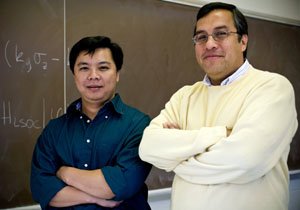Oct 21 2009
For decades, the transistors inside radios, televisions and other everyday items have transmitted data by controlling the movement of the electron's charge. Scientists now have discovered that transistors could use less energy, generate less heat and operate at higher speeds if they exploited another property of the electron: its spin.
 Graduate student Anh Tuan Ngo and faculty member Sergio Ulloa. Photo credit: Erica McKeehan
Graduate student Anh Tuan Ngo and faculty member Sergio Ulloa. Photo credit: Erica McKeehan
In 1921, scientists discovered that each electron has spin—an inherent angular momentum that makes the electron twirl as it moves around an axis. Since then, researchers around the world and at Ohio University have been developing electronic devices that embed data inside an electron’s spin. The emerging field of spin electronics—or spintronics—could revolutionize memory storage devices and quantum computers.
Until now, scientists developing spin electronics have controlled spin by attaching an external magnet directly to the devices. But with the demand for smaller transistors on the rise, using a bulky magnet is not an efficient or practical way to manipulate the orientation of an electron’s spin, said Sergio Ulloa, professor of physics and astronomy at Ohio University.
“The holy grail in spintronics is to address spin with something other than magnets,” said Ulloa. “An electrical field is portable and easy to switch on and off.”
Ulloa and graduate student Anh Tuan Ngo helped solve this problem by providing theoretical modeling for a recent experiment that was the first to successfully control an electron’s spin using purely electrical fields. These findings were published in the journal Nature Nanotechnology.
The team collaborated with a research group at the University of Cincinnati, led by Philippe Debray and Marc Cahay. Debray conceived and designed the experiments. The Ohio University researchers’ calculations explained the behavior of the electrons in Debray’s experimental conditions and predicted how strong the electric field’s control over the spin would be.
Their research also revealed one of the key conditions of the experiment—that the tiny connection along which the electrons travel in the device must be asymmetrical.
“Imagine that you’re walking through a forest and there are mountains on either side of you. If on one side the mountains are taller, you will be able to tell which direction you are walking,” Ulloa said. “The electron will know there is asymmetry, and its spin will be able to tell which way is up.”
Controlling spin electronically has major implications for the future of novel devices such as transistors, but this experiment is only the first step of many, Ulloa said. The next step would be to rework the experiment so that it could be performed at a higher, more practical temperature not requiring the use of liquid helium.